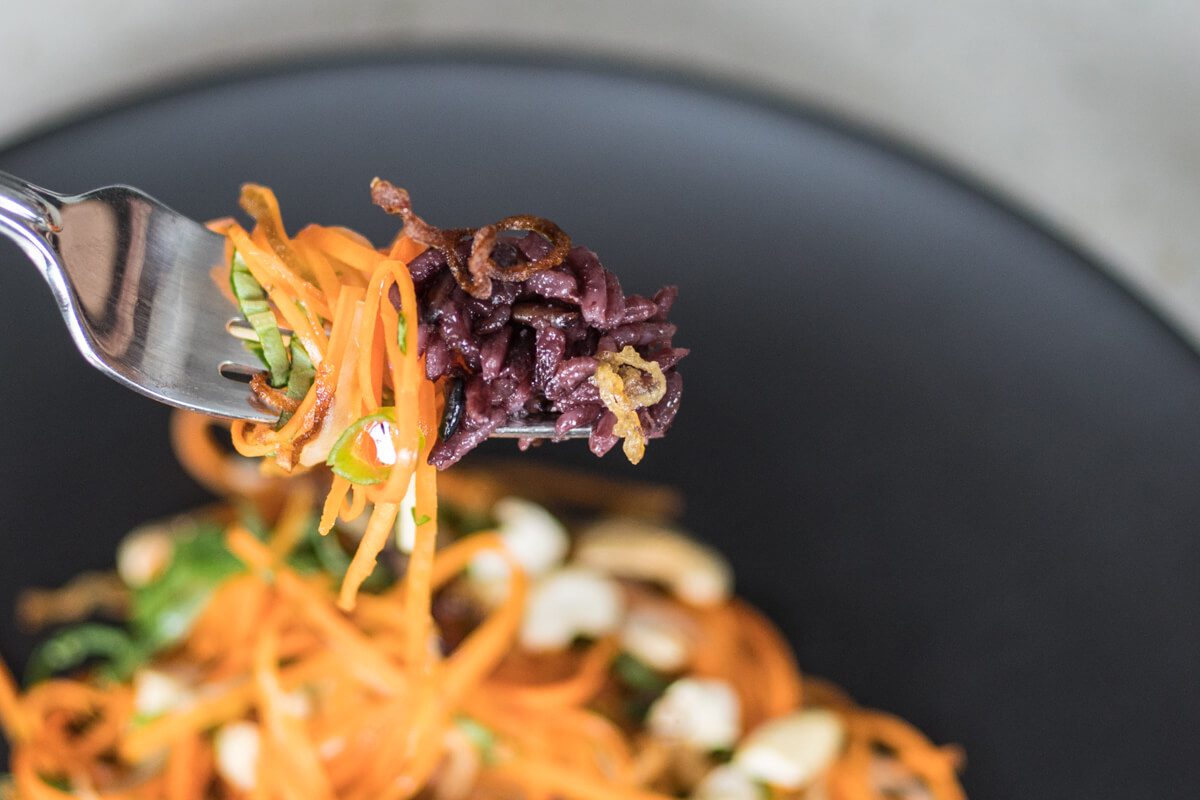
Last week Clayton went on a trip to Portland with his friend Thomas to explore the food and beer scene. He had a fun three days of photography, eating, and drinking, and came back with a few favorite places we’ll be sharing over the next few weeks.
Every single person who gave us food recommendations for the trip said that Pok Pok was not to be missed, so the guys stopped for lunch. They tried the vegetarian versions of the Papaya Pok Pok, Chayote Phat Khai, and Yam Samun Phrai.
Clayton’s favorite was the Yam Samun Phrai, a Chiang Mai version of a Thai herbal salad with white turmeric, carrot, parsnip, betel leaf, basil, lime leaf, lemongrass, sawtooth, fried shallots, cashews, peanuts, sesame seeds, and Thai chiles in a mild coconut milk dressing. As soon as he got home, he set out to recreate this dish at home for our friend Kelly’s birthday dinner at our house.

Clayton had two goals in mind in looking through recipes for this dish. First was to simplify it into something that anyone would (and could) actually make at home. This meant eliminating the most difficult to find ingredients and simplifying the prep as much as possible. Second, since the version they had at Pok Pok was vegetarian and no one missed the meat, he made it completely vegan.

The recipe looks like it requires a lot of prep, but using a mandoline makes quick work of chopping all the vegetables. Use the julienne blade to prep the carrots, parsnip, and ginger. Take out the julienne blade and shave the lemongrass stalk, onion, and shallots into thin slices. We use a Japanese mandolin because they are very sharp and fairly inexpensive, and the blade comes out easily for cleaning and sharpening.
This Japanese mandoline will work for this recipe, but we use this larger version that makes it easier for cutting larger items like eggplants. If you prefer a mandoline with more features, like the ability to waffle cut, you will need one like this, this or this.
We served our Thai herb salad on a of bed Thai purple sticky rice and topped it with mung bean sprouts to add more vegetables. We plated it on our Onyx Heath Ceramic Coupe plates to show off the bright colors of the dish. You can find similar here, here, and here.
- 1½ tablespoons simple syrup
- 1½ tablespoons lime juice
- 1 tablespoon coconut milk
- 2 Thai chiles, thinly sliced
- 1 cup lightly packed julienned carrots, cut into 3-inch-long strips
- ¼ cup lightly packed yellow onion, thinly sliced
- ¾ cup lightly packed parsnip, julienned
- 1 tablespoon fresh ginger, grated
- 1 tablespoon lemongrass, tender parts only thinly sliced
- 1 tablespoon unsalted cashews, roughly chopped
- ½ teaspoon fresh Kaffir lime leaves, thinly sliced or lime zest
- 1 teaspoon cilantro, thinly sliced
- 2 teaspoons Thai basil, thinly sliced
- 1 tablespoon shallots, thinly sliced
- Thai purple sticky rice
- Mung bean sprouts
- For the dressing, mix the simple syrup, lime juice, coconut milk, and Thai chiles in a small bowl. Set aside.
- Julienne the carrots, parsnip, and ginger on a mandoline fitted with the julienne blade. Remove the julienne blade and shave the onion, lemngrass, and shallots.
- Fry the shallots by heating 2 cups of canola oil in a saucepan. Make sure to use a pan that is no more than half full when the oil is added. Heat the oil to 275 F and fry the shallots in the oil for 8 minutes, or until golden. Remove and set on a plate, and increase the heat of the oil to 375. Drop the shallots back into the oil for one second (no more!) and remove to a plate with paper towels. Be very careful as they will burn very quickly.
- Heat a large skillet over medium heat and add the dressing. Warm until it just begins to steam, then add the carrots, onion, parsnip, ginger, and lemongrass to the pan. Toss until the vegetables are coated and barely warm. Put the mixture on a serving platter and top with the lime, cilantro, Thai basil, cashews, and fried shallots. Serve immediately with rice and sproutes.